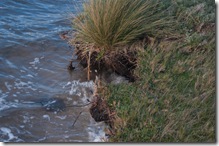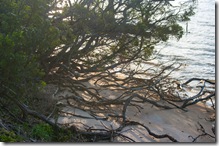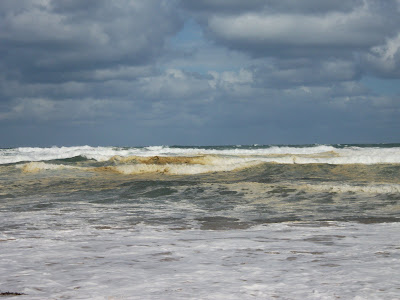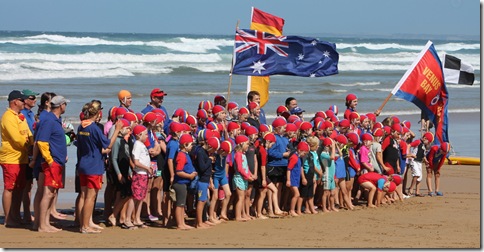Monday, December 24, 2012
Hooked on Bidgee-Widgee
Thursday, November 29, 2012
Hot Hot Hot!!!
Common Bottle-daisy Lagenophora stipitata
Saturday, September 22, 2012
Something To Sing About
Wednesday, August 8, 2012
Focusing on Andersen Inlet erosion risks
I guess there has been a lot of discussion in this blog about changes on the surf beach at Venus Bay but in reality the most significant erosion is going on all along Andersen Inlet.The deeper channels (think of them as a submerged meandering but tidal streams) are snaking back and forth changing position within the inlet progressively widening the inlet and eroding its banks (particularly at Inverloch, on the north eastern side, and around doyle’s road, on the western side. Sand is progressively moving deeper into the inlet and this hinders the development of mangroves, which are really the only way to slow down eroding the shores. The open “beaches” allow waves to undercut the peat layer of the salt marshes and once compromised like this the salt marshes quickly wash away. Trees offer only slightly more resistance but they soon also succumb to the erosion.
Tuesday, June 19, 2012
Did the earth move for you?
 Last nights earthquake between Moe & Mirboo North, best estimates at the moment a 5.4 Magnitude at 8:54PM, gave the folk in Melbourne a good shaking, but how was it felt at Venus Bay?
Last nights earthquake between Moe & Mirboo North, best estimates at the moment a 5.4 Magnitude at 8:54PM, gave the folk in Melbourne a good shaking, but how was it felt at Venus Bay?Geoscience Australia likes to get reliable first hand accounts of what people felt, as it helps them improve both the assessment and prediction of the effects of earthquakes & damage. If you want to help here is the link,
Saturday, June 16, 2012
Having fun …BUT
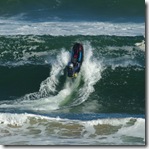

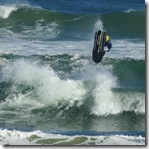
These very noisy mechanized wave runners are obviously have fun, albeit in a high risk way BUT they certainly didn’t impress the other beach one users. The fishermen were muttering about yoboos, the pipi gathers were yabbering about the strong smell of the spilt fuel and the tradition board riders shaking their heads in despair, What I notice is their wasn’t a single bird to be seen anywhere close by. Yet up at beach five there were plenty.
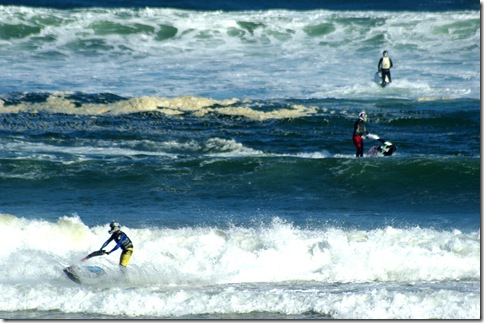
Is this a case of NIMBY over-reaction or is jet skying one of those recreations that really does needs to be controlled in national parks?
Thursday, June 14, 2012
Kings Tides and beach profile
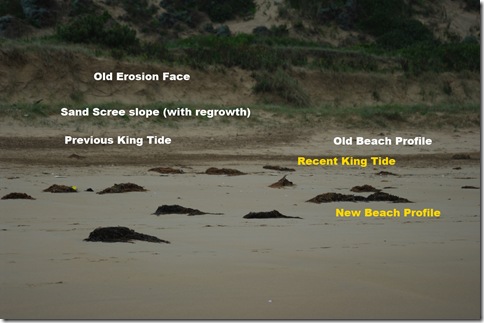
At the same time as last weeks, transit of venus there was also a full moon and a very low atmospheric depression out to the east over the Tasman Sea.. Perfect conditions for a really high tide. I did check the beach on the 7th. and could only see the old erosion face from last year and the regrowth on the sand screen below them. There was a slight notch in several location that looked as if it could be more than a few days old but it was not very extensive (these are labeled in white in the above photo). I revisited the same areas south of beach one today and can see a fresh cut (only 5 to 20cm tall) but extending most of the way along the beach (labeled in yellow). Also the beach below the cut does seem to be “steeper”. So I suspect there has been some significant erosion/sand movement along the beach in the past week. So the picture that the erosion events are most likely to occur with the king tides (full moon) and atmospheric lows does have a little more circumstantial support.
Saturday, June 9, 2012
Venus Bay Inspired Art
The Last Pipi Harvest at Venus Bay
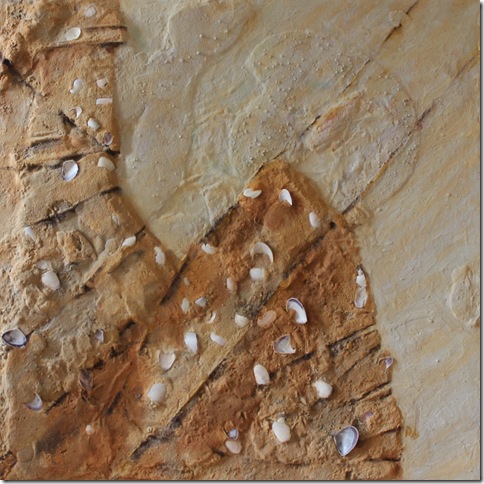
Mixed Media on Canvas
102 by 102cm
By Norm Hanson 2012
 This is a story of anthropogenic extinction, as written into future stone. The ochre coloured sandstone [1] was at one time a thriving beach, brimming with life and specifically a prolific population of Donax Deltiodes, also known as Pipis or Surf clams. However the Pipis were so yummy and they were harvested in such numbers that fewer and fewer shells reached maturity each year. Then suddenly in one season, the entire population failed to reproduce. Worse the rich food chain of the beautiful beach collapsed, with their demise, and the once thriving beach became a pale version of itself. Only a few brave worm burrows [2] could be found. Then all signs of life disappeared [3].
This is a story of anthropogenic extinction, as written into future stone. The ochre coloured sandstone [1] was at one time a thriving beach, brimming with life and specifically a prolific population of Donax Deltiodes, also known as Pipis or Surf clams. However the Pipis were so yummy and they were harvested in such numbers that fewer and fewer shells reached maturity each year. Then suddenly in one season, the entire population failed to reproduce. Worse the rich food chain of the beautiful beach collapsed, with their demise, and the once thriving beach became a pale version of itself. Only a few brave worm burrows [2] could be found. Then all signs of life disappeared [3]. This story need not come true.

The work was created first as a mould of the main units in the sand south of Beach one. This included leaving some of the worm burrow/air holes undisturbed. broken Pipis and other shells where collected nearby and scattered in the mould. The mould was filled with expanding polyurethane foam and cover with the canvas, burried and left to harden for an hour or so. The foam on canvas mould was next painted with several coats of sand, gesso and latex to create an absorbent sandstone like finish. Finally this was “stained” and painted with various oxides. It represents a future geological rock face, perhaps a few million years into our future. This rock face runs close to the bedding planes with the oldest layers, the ochre sandstone on the lower left, closest to you. You are looking "up" in time.
This work will be on display at the Mount View Art Show, 14th - 17th June 2012
Saturday, June 2, 2012
The Transit of Venus
 Providing the skies are cloud free, Venus Bay will be a great place to observe the Transit of Venus. Remember you must not look directly at the sun SERIOUS EYE DAMAGE MAY RESULT.
Providing the skies are cloud free, Venus Bay will be a great place to observe the Transit of Venus. Remember you must not look directly at the sun SERIOUS EYE DAMAGE MAY RESULT. The transits of Venus, they are like an eclipses, are very rare but when they occur there are two such events 8 years apart. During the transit Venus is positioned between us and the sun and casts a shadow. Unlike an eclipse of the moon this show is small and seen as a small dark dot as it moves across the face of the sun.
This is only the fifth transit since James Cook travelled to Tahitti in 1769 to make observation there. Astronomers back in England wanted to know exactly how long the transit took and from that they predicted they would be able to compute the distance of the earth and Venus from the sun. This trip is also famous because on the way back to England he reach Australia, called it New South Wales and claimed it for England.
When?
There are four key events in the transit| First touches the sun |
8:18 AM
|
| Just inside the Sun, ingress |
8:34 AM
|
| Just inside the Sun, egress |
2:27 PM
|
| Last Touches the Sun |
2:45 PM
|
Where is the best place to observe?
Well really anywhere around Venus Bay you can see the sun at the times above. Remember the sun will be relatively low in the sky during the Ingress. So I might start my own observations just near lees Road and Jupiter avenue intersection, on the bike track as it comes off the little rise. There is a very clear view of the eastern sky from here. During the Egress the car park at Beach One is a good location as it has a good view of the north western sky.The Venus Bay, Tarwin Lower Men’s Shed are having activities around observing the transit, weather permitting, including a sausage sizzle & live music from local artists. They will have a solar telescope for safe viewing of the transit, solar flares, sunspots and active regions of the sun. Gold Coin Donation. Check the May edition of Matter of Fact Newsletter for more details.
How to Observe?
I will be using the same method used by captain cook. I will project an image of the sun onto a screen using my telescope. I took the picture below of the transit in 2004 and I’m hoping I can do better this time.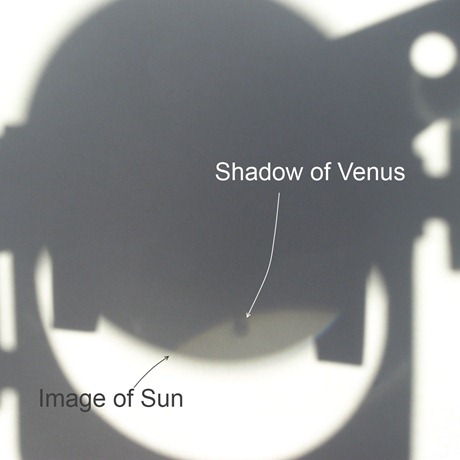
The Sydney observatory has a great factsheet on the 6 June 2012 Transit of Venus. If you’d like more information of making observations yourself, it will even help you do the calculations of distance to the sun and Venus if you want to independently verify the astronomers work.
Wednesday, May 16, 2012
Sand in movement
Sunday, April 8, 2012
Bad weather for Sailors, but good for Diatoms
 jellyfishes and anemones. Their natural habitat is on the surface of the open ocean, where the Ve
jellyfishes and anemones. Their natural habitat is on the surface of the open ocean, where the Ve lella feed on plankton.
lella feed on plankton.They move across the ocean with their distinctive transparent "sail" catching the wind, visible in this first picture.
Every now and again a change of wind direction (like the cold blast we are currently experiencing) blows thousands of Velella helplessly towards the shore.
This second picture shows the underside of the Velella where its feeding tentacles are visible.
The same sort of weather that was responsible for the stranding of the Velella brought waters rich in nutrients that has allowed the Diatoms to bloom along the surf of Beach One.
Monday, March 12, 2012
Saturday, February 4, 2012
WEEDS WEEDS EVERYWHERE!

There is no set definition of what a weed is, other than that they are always undesirable. In the context here I am referring to plants that are not endemic to an area, and that escape into our natural areas to become weeds.

This is undesirable for two main reasons;
- It changes our natural areas from being natural, which is the reason those areas are valued in the first place.
- It alters the balance in the ecosystem. The weeds out compete the native seedlings, so natural regeneration gets hampered. The native animals are all linked to the native vegetation and start to struggle, and pest animal species often displace them.

Learn to recognise a few of the weeds, and which ones are particularly nasty. Below are a couple of useful links,
South Gippsland Weeds;
http://www.southgippslandweeds.com.au/
and the DPI's weed site;
http://www.dpi.vic.gov.au/agriculture/pests-diseases-and-weeds/weeds
The weeds pictured are from top to bottom; Ragwort Senecio jacobaea, Inkweed Phytolacca octandra & Spear Thistle Cirsium vulgare.
Wednesday, January 25, 2012
Celebrating Australia Day
Sunday, January 22, 2012
Death on the Beach

The Life Cycles of the Natural world play out daily along the coast at Venus Bay. Sometime you are confronted by the site of dead birds, like the albatross below, penguins, seals, dolphins and even whale. Unfortunately such deaths happen, frequently related to storms at sea. If you come across such birds, particularly penguins, it is a good idea to check for leg bands, its is import to note which leg is banded and the order of colours and any letters or numbers. Also if the cause of death is clearly not natural (eg the bird, fish is tangled in a net, line) they probably should be recorded. We don't need to be forensic experts or act as" the wildlife police", but significant changes in our environment may be signaled by other species.

VBOPing on Google+
VBOPing is now on Google+, not fully sure how we can us all the facilities of google+ but if you are on Google+ start following and watch for share circles and links. Also add the Hashcode #VBOP to your post so we can find it.
Friday, January 20, 2012
Coastal Walk Report
 The "Geology Rocks" coastal walk along Pt. Smythe yesterday was enjoyed by around 20 people who took the chance for a guided tour through the different environments and habitats of the area. We got to see much of the local plant and animal life, including bracket fungi (species unknown), the White Elderberry Sambucus gaudichaudian which are bearing their pale fruits.
The "Geology Rocks" coastal walk along Pt. Smythe yesterday was enjoyed by around 20 people who took the chance for a guided tour through the different environments and habitats of the area. We got to see much of the local plant and animal life, including bracket fungi (species unknown), the White Elderberry Sambucus gaudichaudian which are bearing their pale fruits.We also saw a few dead birds washed up onto the beach. There was a Muttonbird Puffinus sp. ,and an Albatross (possibly a juvenile Royal Albatross Diomedea epomophora). They most likely perished as a result of a storm event out at sea.

Thanks to Norm and Bruce for making the tour engaging, informative and fun!
Thursday, January 19, 2012
So this is summer …
What is the saying? “Beautiful one day, overcast the next” …Welcome to Venus Bay 2012
This summer so far has not been the typical hot blazing sun and deep blue cloudless skies. yet on the beach there are signs that it has been a much more typical summer than the past few years (at least for the beach profile)
The Erosion at the top of the beach seems to be very limited (last big events being in November) and the scarps are drying and collapsing leaving a steep wedge of sand rather a vertical cliff (except where marram grass clumps are hold up some areas (as shown above). The Average Height Tide Line is 10 to 20 meters seaward from these scarps, which has meant that the flatten out upper part of the beach (the summer berm) has been able to be strongly developed along the beach. This an area where dried out seaweed and other beach debris can accumulate. the sand dries out and is more susceptible to wind erosion so this part of the beach is flatter. This is an important habitat for the shore nesting birds (like the hooded plovers). Hopefully they are enjoying this summer on the beach.
BTW its the Walk out on Point Smythe TODAY!
Monday, January 16, 2012
Point Symthe – Geology walk to Inlet & Ocean Beaches
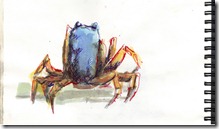 You will find this years geology walk out on Point Smythe area (not to Point Smythe itself) in the Summer by the Sea program list under Geology Rocks!. Sorry no rocks to see but plenty else, including geological processes in action. Perhaps a few experiments on the beach. The route this years has been trimmed (no big dunes to walk up) and there is still plenty to see, in less than 5km.
You will find this years geology walk out on Point Smythe area (not to Point Smythe itself) in the Summer by the Sea program list under Geology Rocks!. Sorry no rocks to see but plenty else, including geological processes in action. Perhaps a few experiments on the beach. The route this years has been trimmed (no big dunes to walk up) and there is still plenty to see, in less than 5km. Fri 20 January 1.30pm – 3.30pm
Bookings Essential (03) 5674 3738Monday, January 9, 2012
Pipi Plunder continues
1) “mule” family groups tipping their catch into larger buckets and carrying those buckets into the dunes.
2) Young male “runners” (often holding radios or mobile phones)collecting the buckets in the dunes and carrying them along tracks in the dunes.
3) People with radio or mobile phones marshalling vans in the beach car parks. (Clearly these vehicles are not full of holiday makers) The licence plates on these vans will probably give the best way to find the organizers of these rackets.
Please take photos and/or report you observations to 13 FISH (a free call number)
Friday, January 6, 2012
Adventures in Environmental Science

I would also like to post a link to a film I made called Adventures in Environmental Science which is about some of the activities of the Venus Bay Observation Project.
I am hoping that those who do view the film would find it to be educational and entertaining, but most of all I hope it inspires others to be brave and become involved and add their contribution to the Venus Bay Observation Project.
Monday, January 2, 2012
This cover a wide range of cpastal matters and in particular a lot of local community groups concerned with there part of our beautiful Victorian coastline.
Whilst at the website check out this year Summer by the Sea program.





+Golden+Whistler+png.png)
+running+postman+png.png)
+native+violet+png.png)
+Hibbirtia+png.png)
+earth+star+png.png)
